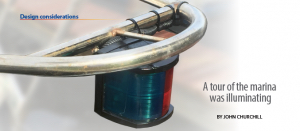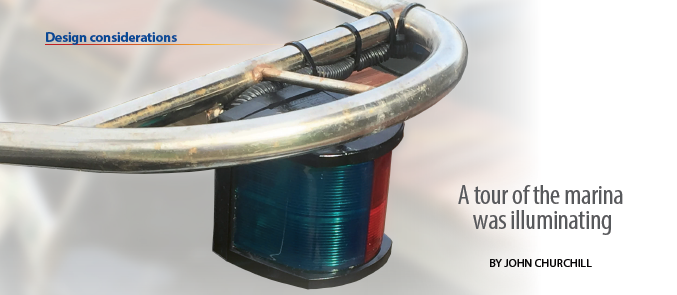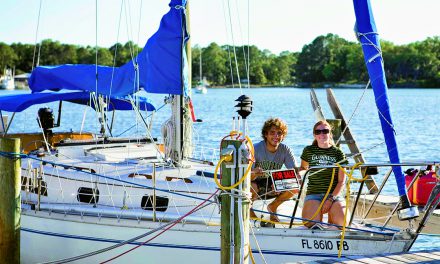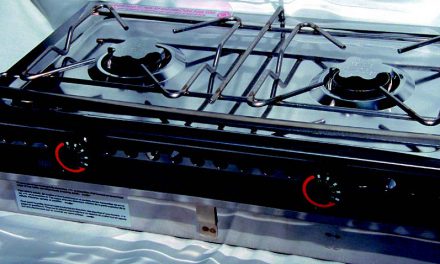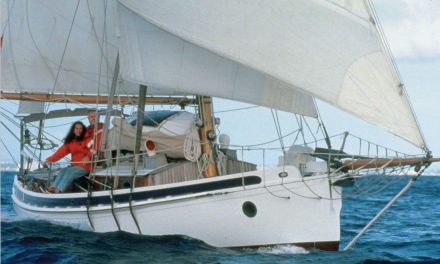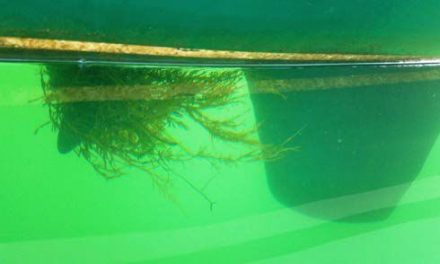A tour of the marina was illuminating

Nurdle’s foredeck-mounted sidelights were underfoot and prone to damage.
My good fortune to live on a small barrier island in Florida is offset by the misfortune of full-time employment that requires me to commute to the mainland daily. My drive is actually fairly pleasant, with almost a third of it on a long causeway across Pine Island Sound. Due to long work hours, I frequently cross during darkness. This has given me plenty of opportunity to observe the navigation lights of boats navigating the sound. While some are bright and appropriately displayed, others have significant defects. I have even seen the red and green lights reversed.
All vessels are required to display navigation lights from sunset to sunrise and in restricted visibility. (See “Rules and Requirements for Navigation Lights,” page 25). While oar-driven boats and unpowered sailboats of less than 7 meters (23 feet) in length might get away with the minimum of a white flashlight, most of our good old sailboats will have sidelights and a sternlight as well as a steaming light for use while under power.
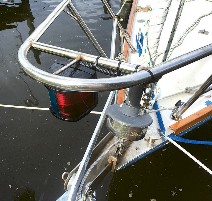
John replaced them with a combination lantern protected by the pulpit.
The steaming light is almost always mounted on the forward face of the mast and the stern light mounting is typically straightforward. Placement of the red and green sidelights can be problematic. The foremost factor to consider, after ensuring red is on the port side and green on the starboard side, is visibility to other vessels. Size of fixtures, heeling under sail, and the potential for the lights to be obscured by sails must be taken into account.
Careful installation will ensure the lights are visible within the correct sectors. Reflected glare must be minimized to maintain the helmsman’s night vision. It’s also important that the lights be protected against damage from flogging sails and running rigging, mooring and dock lines, and fixed obstructions such as pilings. Accessibility is also a priority in case it becomes necessary to change a bulb under way.
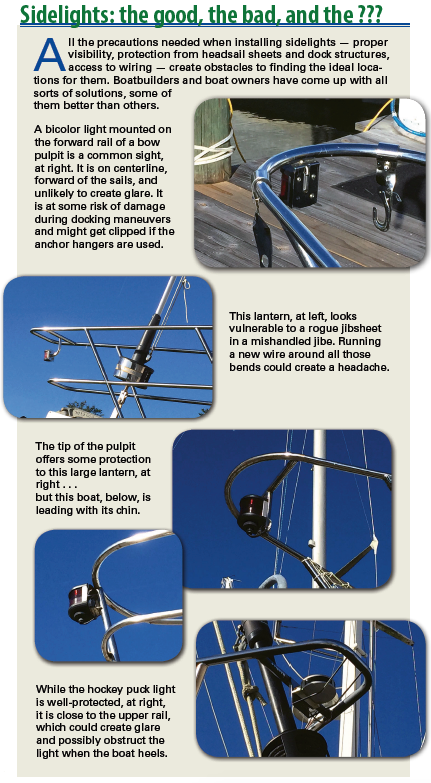 On Nurdle, my 1979 Bristol 35.5, the sidelights were mounted forward on the toerails. As individual lights, they required twice the current of a combined fixture. Being at deck level, they were often wet and were frequently stepped on by crew working at the headstay or the forward chocks. They also inhibited a fair lead for docklines and were prone to fouling the jib’s furling line.
On Nurdle, my 1979 Bristol 35.5, the sidelights were mounted forward on the toerails. As individual lights, they required twice the current of a combined fixture. Being at deck level, they were often wet and were frequently stepped on by crew working at the headstay or the forward chocks. They also inhibited a fair lead for docklines and were prone to fouling the jib’s furling line.
To fix a worsening leak at the hull- to-deck joint, I recently replaced the toerail. As the sidelights had significant shortcomings, I took this opportunity to re-engineer them. To help stimulate my thinking, I visited a local boatyard to look at alternative arrangements. What I saw (see the photos on pages 25 to 27) gave me ideas for how (and how not!) to make a better installation.
A satisfactory solution

I had a tube and plate welded across the forward part of Nurdle’s pulpit to support a combination light. An additional rod helps protect the fixture against damage from sails and running rigging as well as from impacts when docking. The higher, more forward location makes the lights more visible to other vessels, reduces reflected glare off fittings and sails, and ensures that they won’t be obscured by sails. I selected the largest fixture that would reasonably fit. If this light ever needs to be replaced, a new mounting bracket can be fastened to the plate welded onto the pulpit.
Feeding the wire up through the pulpit is always a challenge, but I was able to do it while the pulpit was off for welding. I left the wire plenty long at each end, and I ran a messenger string in case I ever need to pull a new wire. A sacrificial plastic loom protects the wire exposed outside the pulpit from UV degradation. A gob of silicone seals against water and immobilizes the wire against chafe.
 Studying other installations allowed me to improve on the original installation greatly. I can now sail under a bridge at night knowing that unfortunates on their commute will not be disparaging my inadequate sidelights.
Studying other installations allowed me to improve on the original installation greatly. I can now sail under a bridge at night knowing that unfortunates on their commute will not be disparaging my inadequate sidelights.
Rules and requirements for navigation lights
The rules for placement and intensity of navigation lights are spelled out in Colregs Part C, Rules 20-23 and 25. They can be found in print in Navigation Rules, together with the United States Inland Rules, and online at www.navcen.uscg.gov/?pageName=navRulesContent and www.navcen.uscg.gov/pdf/ navrules/navrules.pdf.

